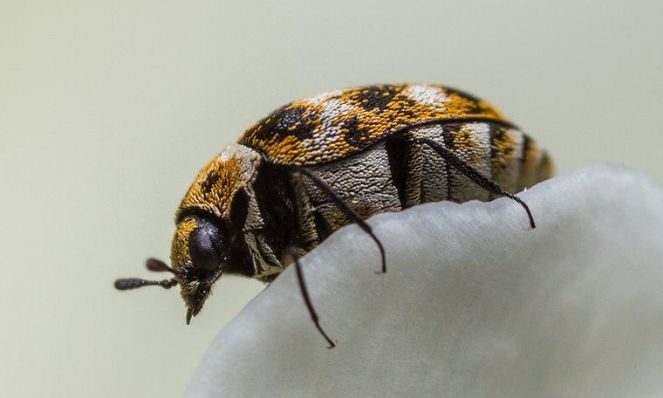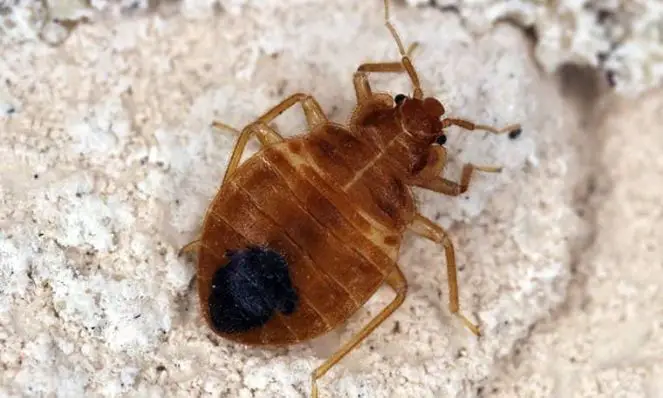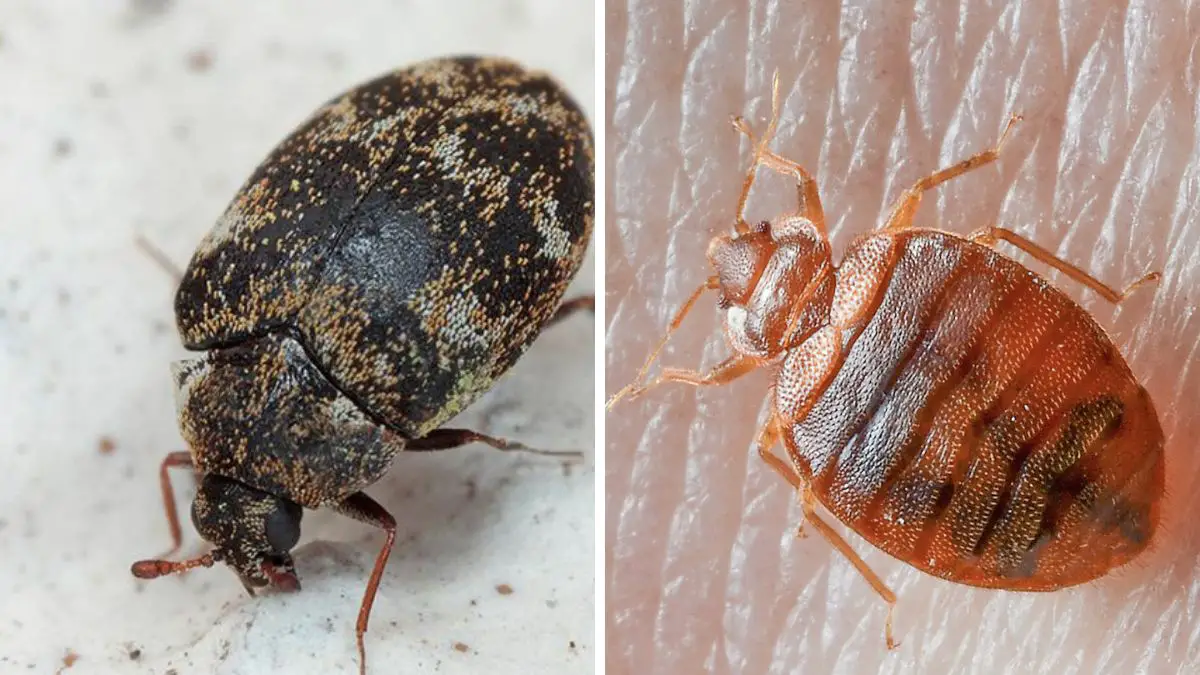Pests can be a real headache for homeowners, and two pesky offenders are carpet beetles and bed bugs.
While they might seem similar at first glance, they have unique traits and behaviors that set them apart.
This blog post delves into the key differences between carpet beetles and bed bugs and provides practical tips on identifying, treating, and preventing infestations. Let’s get started!
Carpet Beetles – The Basics

Carpet beetles are tiny bugs often found indoors, munching on natural fibers like carpets, upholstery, and clothing.
They’re about 1/8 to 1/4 inch long and have colorful, oval-shaped bodies. Unlike bed bugs, they don’t bite humans or pets.
Instead, they feast on organic materials like dead insects, hair, pet dander, and pollen.
Identifying Carpet Beetle Infestations
Carpet beetle infestations can be a significant concern for homeowners, as these tiny insects can cause damage to fabrics, carpets, and other materials.
This section will outline the top signs indicating a carpet beetle infestation so that you can identify it and take action before the problem worsens.
- Damaged Fabrics and Carpets: One of the primary signs of a carpet beetle infestation is finding damaged fabrics, including clothing, upholstery, and carpets. Carpet beetle larvae feed on natural fibers like wool, silk, and cotton, leaving irregular holes or worn spots on these materials.
- Presence of Shed Skins: Carpet beetle larvae molt their exoskeletons as they grow, leaving behind tiny, shell-like skins in infested areas. These light-colored skins are an indication of active carpet beetle activity.
- Silk-Like Webbing: In certain species of carpet beetles, larvae spin silk-like webbing as they move and feed. Look for these fine, silky strands on fabrics and carpets as a sign of an infestation.
- Fecal Pellets: Carpet beetle larvae produce small, pellet-shaped fecal droppings, resembling sand or black pepper grains. These tiny pellets can be found near the infested areas.
- Adult Carpet Beetles: Spotting adult carpet beetles near windowsills, walls, or light sources can indicate an ongoing infestation. Adult carpet beetles are small, oval-shaped insects with colorful patterns on their backs.
- Accumulation of Dead Insects: Carpet beetle larvae are scavengers and may feed on dead insects, such as flies or spiders. Finding an accumulation of dead bugs in certain areas could indicate a carpet beetle presence.
- Damage to Natural Fiber Clothing: Carpet beetles can damage stored clothing made of natural fibers, such as wool, fur, or leather. Check your closets or storage areas for signs of infestation on these materials.
- Attic or Basement Infestations: Carpet beetles prefer dark, undisturbed areas like attics, basements, and storage rooms. Keep an eye out for signs of infestation in these spaces.
- Irregular Patterns of Damage: Unlike some other fabric pests, carpet beetle damage appears irregular and scattered. Look for random holes or worn areas in fabrics and carpets.
- Seasonal Activity: Carpet beetles may show seasonal activity, being more prevalent in warmer months. Monitor your home for signs of infestation throughout the year.
Bed Bugs – Unwanted Nighttime Intruders

On the other hand, bed bugs are small, blood-sucking insects infamous for infesting homes, especially beds, couches, and sleeping areas for humans or pets.
They’re about 4 to 5mm long and have flat, round bodies that turn a peculiar reddish color after feeding.
Unlike carpet beetles, bed bugs solely feed on blood and typically bite humans while they’re asleep.
Spotting Bed Bug Infestations
Bed bug infestations can be a major nuisance and a cause for concern in any home. These tiny blood-sucking pests are experts at hiding, making it challenging to detect them early.
Here are some easy indicators that will help you confirm that bed bugs have moved in!
- Unexplained Red Bites on Skin: One of the most common signs of a bed bug infestation is waking up with unexplained red, itchy bites on your skin. Bed bugs are nocturnal and often feed on human blood at night, leaving behind small, red, and often itchy bite marks.
- Linear Bite Patterns: Bed bugs tend to feed in a pattern, often in a row or cluster of bites. These bites may appear linearly on exposed skin areas like the arms, legs, neck, or face.
- Dark Stains on Sheets and Mattresses: After feeding, bed bugs may excrete tiny droplets of blood, leaving behind rusty or dark stains on your bed sheets, pillowcases, or mattress. These stains are often a result of their digestion process and can be a crucial indicator of an infestation.
- Small Dark Specks on Bedding or Furniture: In addition to blood stains, you may also notice small black or brown dots on your bedding, furniture, or walls. These spots are bed bug excrement and resemble specks of pepper.
- Empty Light-Colored Shells: As bed bugs grow and mature, they shed their exoskeletons. Look for discarded light-colored shells or exoskeletons around your sleeping area, particularly near the seams of mattresses or hiding spots.
- Musty Odor: Bed bugs release a distinct musty odor, often described as a sweet, rotten raspberry scent. If you detect an unusual, pungent smell in your bedroom or surrounding areas, it could be an indication of a bed bug infestation.
- Finding Live Bed Bugs: While bed bugs are skilled at hiding during the day, you might still spot them with your naked eye. Look out for live bugs crawling on your mattress, bed frame, headboard, or furniture. They are about the size of an apple seed, flat, and reddish-brown in color.
- Fecal Trails on Walls and Furniture: Bed bugs often leave behind dark streaks or trails of excrement on walls, furniture, or other surfaces they traverse. These trails can be an additional sign of their presence.
- Blood Smears on Sheets or Clothing: If you accidentally crush a bed bug while you sleep, you may notice small blood smears on your sheets, pajamas, or clothing.
- Presence of Bed Bug Eggs: Bed bug eggs are tiny and pearly white in color, about the size of a pinhead. They are usually laid in hidden locations, such as mattress seams, cracks, crevices, or behind wallpaper.
Treating Bed Bug & Carpet Beetle Infestations
Dealing with carpet beetle and bed bug infestations requires swift action to minimize damage and discomfort.
Here are some effective methods for tackling bed bug and carpet beetle infestations, ranging from DIY solutions to seeking professional assistance!
Treating Bed Bug Infestations
- Wash and Dry Infested Items: Start by washing all infested bedding, clothing, and linens in hot water (at least 120°F or 49°C). Afterward, dry them on high heat for at least 30 minutes to kill any bed bugs and their eggs.
- Vacuum Thoroughly: Vacuum your entire home, paying particular attention to your mattress, furniture, baseboards, and any cracks and crevices. Dispose of the vacuum bag in a sealed plastic bag outside your home to prevent reinfestation.
- Steam Treatment: Steam can effectively kill bed bugs and their eggs. Use a high-temperature steam cleaner to target hidden bugs on your mattress, furniture, and other infested areas.
- Encase Mattresses and Box Springs: Invest in bed bug-proof mattress and box spring encasements to trap any bed bugs inside and prevent new ones from infesting these areas.
- Natural Remedies: Consider using natural remedies like diatomaceous earth or essential oils (e.g., lavender or tea tree oil) to repel and kill bed bugs. Apply these bed bug traps in infested areas.
- Insecticides: For severe infestations, consult a professional exterminator who can use safe and effective insecticides labeled for bed bug treatment.
Treating Carpet Beetle Infestations
- Vacuum Thoroughly: Regularly vacuum your carpets, upholstery, and other fabrics to remove carpet beetles, larvae, and eggs. Pay attention to corners, edges, and areas beneath furniture.
- Wash or Dry-Clean Infested Items: Launder or dry-clean any infested clothing, curtains, or fabrics. Hot water and high heat drying can kill carpet beetle larvae and eggs.
- Store Vulnerable Items Properly: Keep natural fiber clothing and susceptible fabrics in sealed plastic bags or containers to prevent carpet beetle infestations.
- Insecticides: Consider using insecticides specifically designed for carpet beetles. Follow the instructions carefully and ensure proper ventilation during application.
- Natural Predators: Introduce natural predators of carpet beetles, such as certain species of parasitic wasps, to help control their population.
- Professional Pest Control: If the infestation persists or worsens, seek help from a professional pest control service experienced in handling carpet beetle infestations.
Preventing Future Infestations
Prevention is the key to keeping carpet beetles and bed bugs away.
Regularly clean and vacuum your home, especially carpets, upholstery, and areas where pets spend time. Store clothing and other vulnerable fabrics in sealed plastic bags or containers.
Keep your sleeping area clutter-free to make it harder for bed bugs to find hiding spots. Using mattress encasements can also protect against bed bug infestations.
Wrapping it Up
Understanding the differences between carpet beetles and bed bugs is vital for effectively dealing with and preventing these common household pests.
By recognizing their distinct characteristics, identifying signs of infestations, and taking prompt action, you can protect your home and keep these unwanted intruders at bay.
Remember, early detection and proactive prevention are crucial for maintaining a pest-free environment.

